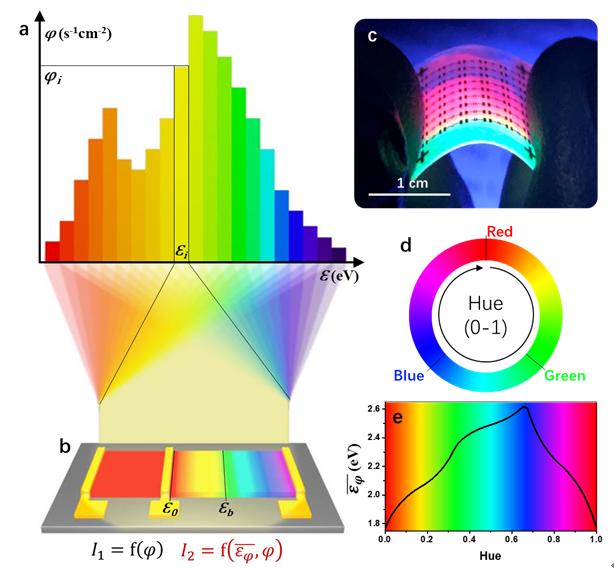
Credit: by Mei-Na Zhang, Xiaohan Wu, Antoine Riaud, Xiao-Lin Wang, Fengxian Xie, Wen-Jun Liu, Yongfeng Mei, David Wei Zhang and Shi-Jin Ding
Human brain can process a massive number of light/spectral signals at high speed, partly because it perceives lights as a combination of colors and intensities. However, the existing photodetectors can only indicate light intensities. It was recently reported that integrating dozens of photodetectors with semiconductors presenting different bandgaps can reconstruct spectral curves of incident lights. Nevertheless, such approach requires chip-level device assembly and signal-processing system, and can generate redundant signals for applications that do not need detailed spectral information.
In a new paper published in Light Science & Application, a team of scientists, led by Professor Shi-Jin Ding from State Key Laboratory of ASIC and System, School of Microelectronics, Fudan University, China, have developed a low cost, flexible optoelectronic cell that can detect light intensity and perceive colour, inspired by human visual and psychological light perceptions (Figure 1). Bandgap-gradient perovskites, prepared by a halide-exchanging method via dipping in a solution, are developed as the photoactive layer of the cell. Since photon absorption can only occur at energies above the bandgap of semiconductors, the devices can sense the spectral content of light signals with high resolution. The fabricated device produces two output signals: one shows linear responses to both photon energy and flux, while the other depends on only photon flux. Thus, by combining the two signals, the single device can project the monochromatic and broadband spectra into the total photon fluxes and average photon energies (i.e., intensities and hues). which are in good agreement with those obtained from a commercial photodetector and spectrometer (Figure 2). Under changing illumination in real time, the prepared device can instantaneously provide intensity and hue results.
Chemical/bio-sensing by applying the colour-perception device is demonstrated. The colorimetric chemical/bio-assay setup is shown in Figure 3: chemical/bio-analytes will modify the colour of the sensing material, and the bandgap-gradient device will convert the colour change to an electrical signal. For this simple proof of concept, a pH testing paper that turns from red to green for pH values from 1 to 9, is used. When using a single silicon photodiode output current, such colour differences are not detectable. Spectral curves of the pH testing papers under the same illumination measured by a spectrometer can distinguish the different colours by presenting different peak positions. However, this method not only requires bulky equipment but also generates spectral information that is redundant for sensing applications. The response of the bandgap-gradient device can clearly distinguish between the various pH values. Therefore, the colour-perception device effectively achieves colorimetric chemical/bio-sensing with only a single device and by generating only one or two current signals.
“We think that bandgap-gradient structures with high degrees of control can be achieved by other fabrication technologies with processing parameters that can produce a gradient. Colour-perception devices with excellent performance, small size and integratable structure would be achieved by further optimizing the selection of the optoelectronic material and the design of the bandgap-gradient structure. This device can be used in colour-sensing pixels, which may be more simplified than existing devices containing several photodetectors and optical filters. Multifunctional sensors can be produced by combining devices with stimuli-responsive materials to detect physical/chemical/bio-stimuli through a comparison of colours/spectra. Therefore, this work provides a new category of optoelectronic devices that are capable of spectrum projection and hue perception, thereby opening up a range of colourful applications.” the scientists forecast.
###
Media Contact
Shi-Jin Ding
[email protected]
Related Journal Article
http://dx.




